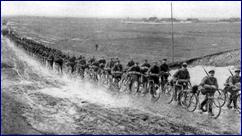| |
By Barry Boyce, CyclingRevealed
Historian
|
|
CyclingRevealed
Presents the World of Cyclocross
A sunny but cold winter day afternoon as the parishioners left of their Sunday mass a strange event gained notice. John and his family, well dressed in their ‘Sunday best,' sauntered toward their home. Suddenly they happened upon an unexpected spectacle of winter. They saw the strange sight of cyclists leaving of the road and beginning to ride through the field and run over the obstacles.
“What a muddy sport!” retorted his wife? A curious man, John approached the group and asked, “What class of cycling is this?” Quickly a joyous reply, “It is called cyclo-cross!”
History
The sport of cyclocross began at the ends of the 19th century in France. Its creator was a French soldier named Daniel Gousseau , who frequently rode his bicycle over the rough trails and difficult obstacles to maintain cycling fitness during the winter months. Generals on horseback observed this strange discipline and moved quickly to train the French Army troops on bikes.

The first National Championships were run in France in 1902. Belgium organized their first championship 8 years later in 1910. Then others followed: Switzerland (1912), Luxembourg (1923), Spain (1929) and Italy (1930). The first competitions were more what a mountain bike rally is today. They would consist of leaving one point and arriving at another, after crossing fields, forests, hills and rivers. The first rider to pick-up the bike, carry it on the shoulder and run with greater agility was the winner of the 1910 Tour of France, Octave Lapize (Fra). Tragically this great French champion died during an air battle during World War 1. But Lapize's style was adopted by another rider, the original “eternal second” Eugene Christophe. The practice of carrying the bike on the shoulder served him well when in the 1913 Tour de France he had to run down most of the Col du Tourmalet with his broken bike in search of a forge. Cyclo-cross helped start a great Tour de France legend in 1913.
The first important event of cyclocross was called the “Criterium International.” It took place in 1924 and was organized in a forest west of Paris . The race was in a rural area and attracted great enthusiasm from the public. Year after year the competition continued and became increasingly popular. The crown favorite was a terrifying descent known as the “Trou du diable” (the hole of the devil, or today: the drop of death). This was where a very dense crowd concentrated to see the better cyclists showed their abilities and the lesser ones rolled down with the bicycle like a ball.
Development
Slowly cyclocross was developing great popularity and promoters searched for short circuits to facilitate spectator's overall vision. Driven by this popularity they looked to central areas of cities, where the courses were characterized by long sections of stairs, paved streets, gardens and small fences (or barriers) similar to the ones utilized today.
As the development progressed, the “ Criterium International de Cyclo-Cross ” gave way to the World Professional Cyclo-Cross Championships in 1950. The first official World CC Champion was Jean Robic (Fra). Robic, who in 1947 won the Tour de France. He is still the only TdF champion to win the World CC Championship. After Robic the championships were dominated by long “reigns of champions.” Roger Rondeaux (Fra)- 1951, 52, & 53, Andre Dufraisse (Fra)- 1954, 55, 56, 57, & 58, Renato Longo (Ita) 1959, 62, 64, 65, & 67, Eric de Vlaeminck (Bel)- 7 WC victories in 8 years ( he was the Eddy Merckx of cyclocross ), Albert Zweifel (Sui)- 1976, 77, 78, & 79, Roland Liboton (Bel)- 1980, 80, 82, 83, & 84.
In the 80+ years the CX discipline underwent great changes and the sport developed. The “routiers” (strong TT type riders in the peloton) began to realize that good winter ("dead seasons") training in cyclocross provided great preparation for the road season. In an effort to attract more and more road riders the UCI (cycling's governing body) began to standardize the racecourses, making them easier and faster. The “Trou du diable” descents were eliminated (or at least made easier).
As the sport grew, some riders abandoned the road-racing schedule and became cyclocross specialists. These cyclocross specialists began to emerge in the mid-1970s and the racecourses slowly returned some of the difficulty of previous years. Today, there are professional cyclocross riders that are paid year round to dedicate themselves to the winter cycling sport.
In the modern era the UCI established regulations to standardize the difficulty of the racecourses. Each circuit should have paved roads, forest and field sections, and obstacles to break the rhythm of the rider. The typical racecourses should be a circuit of a minimum of 2.5 km and a maximum of 3.5 km in length. A properly designed course is 80% to 90% ridable with as many as 4 natural and/or artificial obsticles.
The cyclocross schedule begins early in September in Belgium and finishes late in February. Because of the road season the CC schedule will vary according to the countries. In France the traditional start is in October, while in Spain it is November.
There are three major objectives for the cyclocross rider:
1. The World Cyclocross Championships (end of January or early February);
2. The World Cup (various events from November to January); and
3. the Super Prestige Cup (7 or 8 events from October to February).
Historical Results
|
|
